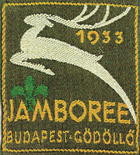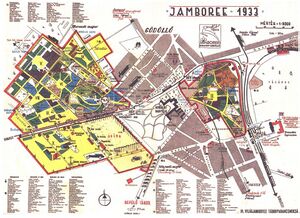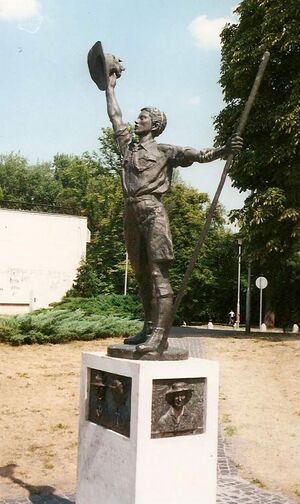4th World Scout Jamboree: Difference between revisions
(→External links: update WOSM navbox using Project:AWB) |
m (1 revision: import from en.wikipedia) |
(No difference)
| |
Revision as of 10:49, 17 January 2010
| 4th World Scout Jamboree | |||
|---|---|---|---|
 | |||
| Location | Gödöllő | ||
| Country | Hungary | ||
| Date | 1933 | ||
| Attendance | 25,792 Scouts | ||
|
| |||
The 4th World Scout Jamboree, a gathering of Boy Scouts from all over the world, was hosted by Hungary and held from August 2 to August 13, 1933. It was attended by 25,792 Scouts, representing 46 different nations and additional territories. They encamped around the Royal Palace in the Royal Forest of Gödöllő, about 11 miles from the capital of Budapest.
In attendance
It was the second-to-last Jamboree for the founder of Scouting, Robert Baden-Powell. Baden-Powell and Hungarian head of state, Regent Horthy, addressed the Scouts from the grandstand built to accommodate over 5000 guests during an opening ceremony at the rally ground. Regent Horthy told the Scouts,
| “ | Scouts! You have come to Hungary from all parts of the world to testify to the magnificent and uplifting powers of brotherhood represented by Scouting. The noble ties of friendship will, I believe, become even stronger among you through this Fourth World Jamboree. I am convinced that the Jamboree will do much toward the promotion of good-will and peaceful cooperation, for the general good of humanity. The Hungarian nation offers you with love these wood-girt fields for your camping. The Hungarian nation welcomes you and your leader, the founder of the World Scout Movement, Lord Baden Powell. Welcome to you all! I hope you will feel at home![1][2] | ” |
The Jamboree Camp Chief was the Chief Scout of Hungary, Count Teleki Pál, a member of the International Committee who had previously been and would later once again become Prime Minister of Hungary. The General Camp Manager was Vitez Kisbarnaki Ferenc Farkas, a general staff officer of the Hungarian Royal Army, who was later appointed the Chief Scout of Hungary upon Teleki Pál's death in 1941.[3]
This event was notable as the first international gathering where Air Scouts were represented, including the famous pilots, László Almásy and Robert Kronfeld.[4][5] A meeting of Skolta Esperanto Ligo took also place at the Jamboree.
Countries and territories with contingents of Scouts present included Hungary, Scotland, Wales, Northern Ireland, the Irish Free State, England, Jamaica, Trinidad, Switzerland, Sweden, Armenia, the Netherlands, Poland, Finland, Czechoslovakia, Estonia, Australia, New Zealand, British Guiana, Canada, Newfoundland, Ceylon, South Africa, Austria, Romania, Norway, Portugal, Siam, Spain, Haiti, Greece, France, Gibraltar, India, Philippines, United States, Bulgaria, Liechtenstein, Belgium, Syria, Denmark, Iceland, Egypt, Iran, Japan, Malta, Palestine, Rhodesia, the Duchy of Luxemburg, and Russian Emigrant Scouts.[6] They lived in ten sub-camps. The overall encampment was serviced by its own post office, ambulance station, hospital, a steam railroad and station, and an electric local streetcar line with four stations.[7]
The Jamboree daily paper, Magyar Cserkész, was printed in Hungarian, English, French and German, with contributions in other languages. Every foreign group at the Jamboree was assigned a "cousin"—a Hungarian Scout who spoke their language and served as translator and guide.[5] They wore on their right arm a white band displaying two interlocked hands embroidered in red. Over their shirt pocket they wore an embroidered patch stating their language specialty, for example, Parle Francais, Spricht Deutsch or Speaks English.[8]
During the Jamboree, about 100,000 people from the nearby city of Gödöllő and the surrounding districts visited the Scouts from many nations, seeking "autograms"—autographs—and "change," or to trade clothing, patches, and more.[2]
Jamboree symbol: the White Stag
The white stag of Hungarian mythology was the national symbol of Hungary and the official badge of the Jamboree. During the Jamboree, Scouts from the American contingent learned from their Hungarian "cousin" the meaning of the White Stag on their jamboree patch:
| “ | One day, many years ago, Hunor and Magor, the two sons of King Nimrod of the Orient, were out hunting with a number of their men. Suddenly, from a thicket, jumped the most beautiful deer they had ever seen. Immediately they started in pursuit. Over mountain sides, through valleys and forests, across rivers, they followed the magnificent animal, until, with darkness, they lost track of it. There was nothing for them to do except make camp right where they were and await the coming of morning.
When they awoke the next morning, a gorgeous sight greeted their eyes. In their wild ride, they had crossed the borders of their own country and had arrived in another of which they had never heard, a country richly endowed with good soil, beautiful forest, fruits, flowers, game and fish. Hunor and Magyar, decided that this was the land of their choice. They went back for their father's blessing and then returned with their wives to their new rich country. Through the ages they prospered. The descendants of Hunor became the Huns and of Magor, the Magyars, who now form the Hungarian nation.[1] |
” |
Baden-Powell also referred to the symbol of the Hungarian people in his farewell address to the assembled Scouts:
| “ | Each one of you wears the badge of the White Stag of Hungary. I want you to treasure that badge when you go from here and to remember that, like the Golden Arrow, it also has its message and its meaning for you.
The Hungarian hunters of old pursued the miraculous Stag, not because they expected to kill it, but because it led them on in the joy of the chase to new trails and fresh adventures, and so to capture happiness. You may look on that White Stag as the pure spirit of Scouting, springing forward and upward, ever leading you onward and upward to leap over difficulties, to face new adventures in your active pursuit of the higher aims of Scouting—aims which bring you happiness. These aims are to do your duty wholeheartedly to God, to your country, and to your fellow man by carrying out the Scout Law. In that way you will, each one of you, help to bring about God's kingdom upon earth—the reign of peace and goodwill. Therefore, before leaving you, I ask you Scouts this question—Will you do your best to make friendship with others and peace in the world? |
” |
Among the boys attending was 14-year-old Béla Bánáthy, who met Baden-Powell when he inspected Béla's campsite, and was inspired as an adult to draw on the myth of the white stag from Hungarian mythology when he organized the White Stag Leadership Development Program in Monterey, California in 1958. In Monterey, Béla would meet three other men who had attended the Jamboree: Joseph Szentkirályi (later Americanized as Joseph St. Clair) became Chairman of the Hungarian Language Department at the Army Language School; Paul Ferenc Suján (whose stew was tasted by Baden Powell at that same Jamboree) was also an instructor at the Army Language School; and American Scouter F. Maurice Tripp had become a research scientist and a member of the National Council of the Boy Scouts of America.
At the same time, the newly formed World Association of Girl Guides and Girl Scouts held its first World Camp in Royal Forest of Gödöllő from July 25 to August 7, 1939, and attended by some 5,800 Girl Guides from around the world. They named the camp Pax Ting.
Related events
To commemorate the tenth anniversary of the Jamboree, a statue by sculpture Lőrinc Siklódi of a Boy Scout was erected on October 17, 1943 across from the Guard Barracks in Royal Forest of Gödöllő, Hungary. After Communist forces liberated the country from Nazi Germany, the original statue by sculptor Lőrinc Siklódi was removed during 1948 when the Iron Curtain fell and the government moved to suppress Scouting. In 1994, after democracy and Scouting was reestablished in Hungary, the community around Gödöllő moved to locate and re-erect the statue.
After a long search, the original statue could not be found, and a committee was established with the purpose of erecting a new statue. They decided to enlarge Zsigmond Kisfaludi Strobl's 50 inches (130 cm) statuette entitled The Boy Scout. A student of Kisfaludi Strobl, István Pál, was chosen to complete the work. The new statue of a Boy Scout standing on the original pedestal was unveiled on April 23, 1994, commemorating yet again the 1933 World Jamboree.[10]
In 1993, to celebrate the 60th anniversary of the Fourth World Jamboree, the Hungarian Scout Association Magyar Cserkészszövetség hosted a Fourth World Jamboree Memorial Camp at Bélapátfalva, Hungary.
Teleki Pál, who served as Camp Chief at the Jamboree, is buried at Gödöllõ. He was Prime Minister of Hungary twice and a friend of Baden-Powell's.[11]
See also
References
- ↑ 1.0 1.1 Template:Cite
- ↑ 2.0 2.1 Lew Orans. "4th World Jamboree, Gödöllő, Hungary". http://www.pinetreeweb.com/1933-wj4-news25.htm. Retrieved 2008-11-03.
- ↑ Lew Orans (1996-12-24). "Bela's Story: Scouting in Hungary, 1925-1937". http://www.pinetreeweb.com/bhb.htm. Retrieved 2008-08-12.
- ↑ Pribich, Kurt (2004) (in German). Logbuch der Pfadfinderverbände in Österreich. Vienna: Pfadfinder-Gilde-Österreichs. p. 104.
- ↑ 5.0 5.1 5.2 World Organisation of the Scout Movement. "World Scout Jamborees History". http://www.scout.org/en/information_events/events/world_events/world_jamboree/jamborees_history. Retrieved 2008-08-12.
- ↑ Lew Orans (1998-12-28). "4th World Jamboree Gödöllõ, Hungary, 1933". http://www.pinetreeweb.com/1933-jamboree.htm. Retrieved 2008-08-12.
- ↑ Template:Citation
- ↑ "4th World Jamboree, Gödöllő, Hungary". http://www.pinetreeweb.com/1933-wj4-sjb-04.htm. Retrieved 2008-11-03.
- ↑ Lew Orans (1998-10-02). "Au Revoir" — Not Goodbye!". http://www.pinetreeweb.com/1933-wj4-news47.htm. Retrieved 2008-07-16.
- ↑ Phelps, Brian; Alan Miyamoto, Fran Peterson (1998). "White Stag History Since 1933". http://www.whitestag.org/history/history.html. Retrieved 2008-08-17.
- ↑ Lew Orans (2008-12-23). "Gödöllő, Hungary, 1933". http://www.pinetreeweb.com/godollo.htm. Retrieved 2008-09-07.
External links
- Jamboree Histories at Scout.org
- Jamboree Histories at Scoutbase.org
- 1933 Jamboree at pinetreeweb.com
- White Stag Leadership Development Program


